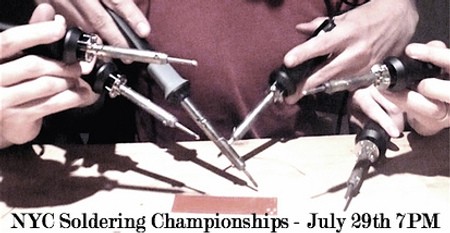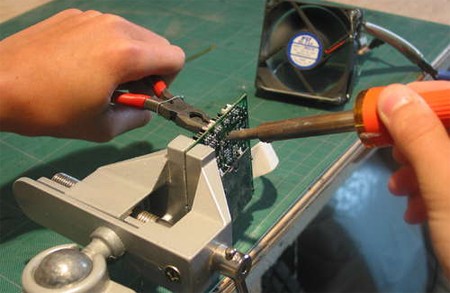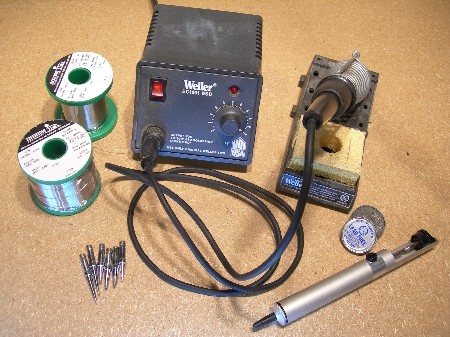
A good soldering station and fume extractor is a must for anyone interested in hacking and modding, but not everyone can afford the expensive professional models on the market. This How-To and the tips within it will guide you through the process of building an inexpensive homebrew fume hood complete with built-in time and temperature controlled soldering station and all the soldering tools you need.
solderingiron6 Articles
NYC Soldering Championships Tonight

The NYC Soldering Championships are happening tonight at Ignite in M1-5. It looks like there might still be some slots open if you want to compete. You can bring your own iron, it’s all through-hole, but you can’t use helping hands. Good luck, and we can’t wait to see how this inaugural event turns out!
[photo: Nick Bilton]
NYC Soldering Championships

[Matt] let us know about the New York City Soldering Championships. They’ll be happening during the Ignite talks on July 29th at 7pm. 25 people will race head to head to assemble a fully functional electronics kit. Participants have to register in advance and are encouraged to bring their own iron. The kit hasn’t been chosen yet so people can’t practice. We hope they at least consider using a few SMD parts just to keep things interesting. Shout out if you’re planning to attend or compete!
[photo: Nick Bilton]
Reusing PCB Components

If you’re anything like us, you have a closet full of old electronics, some broken, some obsolete. You can stop using those as paperweights with the help of this guide that shows you how to recycle and reuse PCB components.
The first step of the process is finding electronics you don’t mind taking apart. Next place the PCB you’ll be stripping in a vice, with the components facing away from you and the solder side facing towards you. Grip the component you want with a pair of pliers, and apply a hot soldering iron to the solder that is holding the component. The solder will melt and allow you to safely and cleanly remove the component.
This process can be applied to virtually any component on an PCB, and the author of the guide, [Patented], got a lot of components this way, including resistors, capacitors, switches, audio jacks, and much more. Don’t forget to toss any free-floating metal or plastic parts in the recycle bin when you’re done. You can feel good about the fact that nothing was wasted, you found parts for your next project, and you cleared out some space.
How-To: Go Green With Lead Free Solder

We covered many of [Jason Rollette]’s personal projects in the past and are happy to welcome him as our newest Hack-A-Day contributor.
The electronics industry has shifted to lead free compliance, but most hobbyists haven’t even considered the personal impact of using lead. Today’s How-To will cover what it takes to switch from tin/lead solder to completely lead free. Our previous posts Introduction to soldering and the follow-up still apply to lead free. You may have never considered switching to lead free before, but we hope to help you make an informed decision.
How-To: Introduction To Soldering
It’s been a while since we’ve had a fresh How-To on the Hack-A-Day, and frankly we’ve missed them. To get things rolling, [Eliot] and I wanted to build a good knowledge base to help you hack your own stuff. I know that soldering won’t be new to many of our readers, but everyone has to start sometime. Our hope is simple: that this new series of How-To’s will help inspire new and experienced hackers alike.











